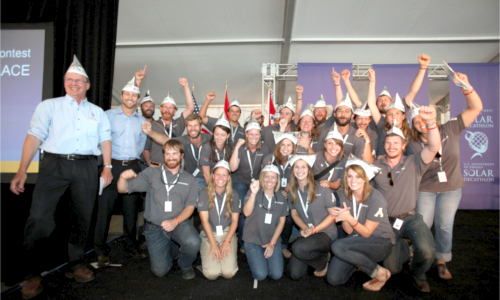

What’s the best way to expose college students to the capabilities of solar energy?
Have them build homes that will rely on it, of course.
The U.S. Department of Energy today announced the 20 teams who will participate in the 2015 Solar Decathlon—a nearly two-year competition in which the teams will work together to build homes that are efficient, affordable and powered by solar energy. The teams—comprised of students from colleges in the U.S. and beyond—will spend several months designing and constructing their homes at the Irvine, CA competition site.
To date, the Decathlon has given hands-on experience in the solar industry to more than 17,000 college students.
[youtube //www.youtube.com/embed/IWisAGofpss expand=1]
“The Solar Decathlon provides the next generation of America’s architects, engineers, and entrepreneurs with the real world experience and training they need to strengthen U.S. innovation and support new, clean sources of energy,” U.S. Deputy Secretary of Energy Daniel Poneman said in a statement.
This year, there are eight returning teams and 12 new teams. The teams from the U.S. are from 13 states, and four teams are partnering with international schools. Here are the 20 teams competing in the 2015 Solar Decathlon:
- California Polytechnic State University
- California State University, Sacramento
- Clemson University
- Crowder College and Drury University
- Lansing Community College and Kendall College of Art and Design of Ferris State University
- Missouri University of Science and Technology
- New York City College of Technology
- Oregon Institute of Technology and Portland State University
- Stanford University
- State University of New York at Alfred College of Technology and Alfred University
- Stevens Institute of Technology
- University of Florida, National University of Singapore, and Santa Fe College
- The University of Texas at Austin and Technische Universitaet Muenchen
- University at Buffalo, The State University of New York
- University of California, Davis
- University of California, Irvine; Saddleback College; Chapman University; and Irvine Valley College
- Vanderbilt University and Middle Tennessee State University
- West Virginia University and University of Roma Tor Vergata
- Western New England University, Universidad Tecnológica de Panamá, and Universidad Tecnológica Centroamericana
- Yale University
The designs of the students’ homes will run the gamut of building technologies, as different teams will be instructed to build homes that would be appropriate for specific markets, climates and locations. In fall 2015, the student teams will give free public tours of renewable energy systems and energy-efficient technologies, products and appliances within their homes.
The 2013 Solar Decathlon at the Orange County Great Park in California drew about 60,000 guests. The Vienna University of Technology in Austria won top honors in 2013.
Visit EcoWatch’s RENEWABLES page for more related news on this topic.

 233k
233k  41k
41k  Subscribe
Subscribe 
